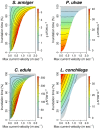A mixed modeling approach to predict the effect of environmental modification on species distributions
- PMID: 24586545
- PMCID: PMC3935846
- DOI: 10.1371/journal.pone.0089131
A mixed modeling approach to predict the effect of environmental modification on species distributions
Abstract
Human infrastructures can modify ecosystems, thereby affecting the occurrence and spatial distribution of organisms, as well as ecosystem functionality. Sustainable development requires the ability to predict responses of species to anthropogenic pressures. We investigated the large scale, long term effect of important human alterations of benthic habitats with an integrated approach combining engineering and ecological modelling. We focused our analysis on the Oosterschelde basin (The Netherlands), which was partially embanked by a storm surge barrier (Oosterscheldekering, 1986). We made use of 1) a prognostic (numerical) environmental (hydrodynamic) model and 2) a novel application of quantile regression to Species Distribution Modeling (SDM) to simulate both the realized and potential (habitat suitability) abundance of four macrozoobenthic species: Scoloplos armiger, Peringia ulvae, Cerastoderma edule and Lanice conchilega. The analysis shows that part of the fluctuations in macrozoobenthic biomass stocks during the last decades is related to the effect of the coastal defense infrastructures on the basin morphology and hydrodynamics. The methodological framework we propose is particularly suitable for the analysis of large abundance datasets combined with high-resolution environmental data. Our analysis provides useful information on future changes in ecosystem functionality induced by human activities.
Conflict of interest statement
Figures








 = 0.975) and realized (sampling from the complete cumulative distribution) intertidal (green) and subtidal (blue) biomass stocks estimated for different year/scenarios. The black dotted line represent the 1∶5 ratio. The black broken line represent the 1∶10 ratio.
= 0.975) and realized (sampling from the complete cumulative distribution) intertidal (green) and subtidal (blue) biomass stocks estimated for different year/scenarios. The black dotted line represent the 1∶5 ratio. The black broken line represent the 1∶10 ratio.Similar articles
-
The role of environmental variables in structuring landscape-scale species distributions in seafloor habitats.Ecology. 2010 Jun;91(6):1583-90. doi: 10.1890/09-2040.1. Ecology. 2010. PMID: 20583700
-
Hydroids (Cnidaria, Hydrozoa) from Mauritanian Coral Mounds.Zootaxa. 2020 Nov 16;4878(3):zootaxa.4878.3.2. doi: 10.11646/zootaxa.4878.3.2. Zootaxa. 2020. PMID: 33311142
-
Integrating Ecosystem Engineering and Food Web Ecology: Testing the Effect of Biogenic Reefs on the Food Web of a Soft-Bottom Intertidal Area.PLoS One. 2015 Oct 23;10(10):e0140857. doi: 10.1371/journal.pone.0140857. eCollection 2015. PLoS One. 2015. PMID: 26496349 Free PMC article.
-
Role of hydrodynamics in shaping chemical habitats and modulating the responses of coastal benthic systems to ocean global change.Glob Chang Biol. 2022 Jun;28(12):3812-3829. doi: 10.1111/gcb.16165. Epub 2022 Mar 29. Glob Chang Biol. 2022. PMID: 35298052 Review.
-
Phreatophytic vegetation and groundwater fluctuations: a review of current research and application of ecosystem response modeling with an emphasis on great basin vegetation.Environ Manage. 2005 Jun;35(6):726-40. doi: 10.1007/s00267-004-0194-7. Environ Manage. 2005. PMID: 15940400 Review.
Cited by
-
The combined influence of body size and density on cohesive sediment resuspension by bioturbators.Sci Rep. 2018 Mar 1;8(1):3831. doi: 10.1038/s41598-018-22190-3. Sci Rep. 2018. PMID: 29497095 Free PMC article.
References
-
- Parmesan C (2006) Ecological and evolutionary responses to recent climate change. Annual Review of Ecology Evolution and Systematics 37: 637–669.
-
- Costanza R, d'Arge R, deGroot R, Farber S, Grasso M, et al. (1997) The value of the world's ecosystem services and natural capital. Nature 387: 253–260.
-
- Araujo M, Guisan A (2006) Five (or so) challenges for species distribution modelling. Journal of Biogeography 33: 1677–1688.
Publication types
MeSH terms
LinkOut - more resources
Full Text Sources
Other Literature Sources

